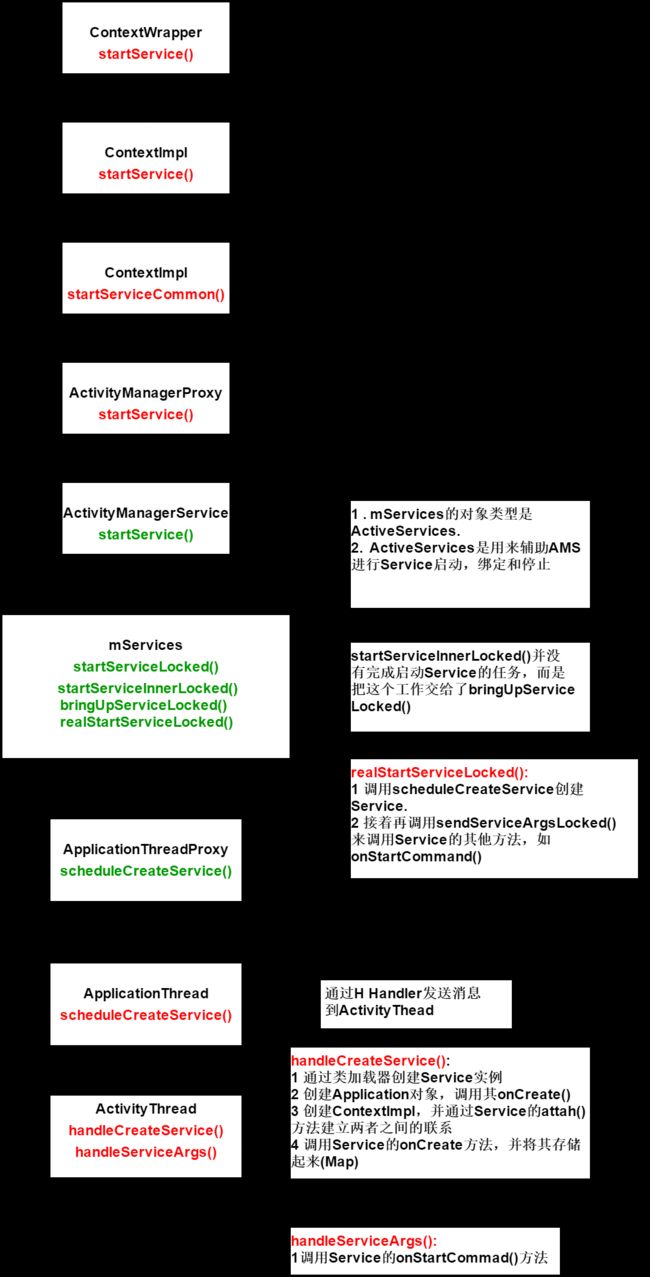参考资料-老罗
一:startService的流程
二:补充-启动Service所在的新进程
因为对于Service我们可以在AndroidManifest.xml文件中指定Android:process属性为其它,比如:remote。这样系统就为Service另起一个进程,并让Service运行在其中。这样就需要创建一个进程,系统为Service创建进程是在bringUpServiceLocked()中。
bringUpServiceLocked():通过startProcessLocked()来创建一个新的进程,以便加载自定义的Service类。最后将这个ServiceRecord保存在成员变量mPendingServices列表中,后面会用到。
public final class ActivityManagerService extends ActivityManagerNative
implements Watchdog.Monitor, BatteryStatsImpl.BatteryCallback {
......
private final boolean bringUpServiceLocked(ServiceRecord r,
int intentFlags, boolean whileRestarting) {
......
final String appName = r.processName;
......
// Not running -- get it started, and enqueue this service record
// to be executed when the app comes up.
if (startProcessLocked(appName, r.appInfo, true, intentFlags,
"service", r.name, false) == null) {
......
return false;
}
if (!mPendingServices.contains(r)) {
mPendingServices.add(r);
}
return true;
}
......
}
ActivityManagerService.startProcessLocked(): 调用Process.start()创建一个新的进程,指定新的进程运行ActivityThread类,
public final class ActivityManagerService extends ActivityManagerNative
implements Watchdog.Monitor, BatteryStatsImpl.BatteryCallback {
......
private final void startProcessLocked(ProcessRecord app,
String hostingType, String hostingNameStr) {
......
try {
......
int pid = Process.start("android.app.ActivityThread",
mSimpleProcessManagement ? app.processName : null, uid, uid,
gids, debugFlags, null);
......
if (pid == 0 || pid == MY_PID) {
......
} else if (pid > 0) {
app.pid = pid;
app.removed = false;
synchronized (mPidsSelfLocked) {
this.mPidsSelfLocked.put(pid, app);
......
}
} else {
......
}
} catch (RuntimeException e) {
......
}
}
......
}
Process.start(): 新建一个进程,然后导入android.app.ActivityThread这个类,然后执行它的main函数。
ActivityThread.main(): 已经是在上一步创建的新进程里面了,即这里的进程是用来启动服务的,在Android应用程序中,每一个进程对应一个ActivityThread实例,所以,这个函数会创建一个thread实例,然后调用ActivityThread.attach函数进一步处理。
public static final void main(String[] args) {
......
Looper.prepareMainLooper();
......
ActivityThread thread = new ActivityThread();
thread.attach(false);
......
Looper.loop();
......
thread.detach();
}
ActivityThread.attach(): 调用ActivityManagerNative.getDefault函数得到ActivityManagerService的远程接口,即ActivityManagerProxy,接着调用它的attachApplication函数。
private final void attach(boolean system) {
......
if (!system) {
......
IActivityManager mgr = ActivityManagerNative.getDefault();
try {
mgr.attachApplication(mAppThread);
} catch (RemoteException ex) {
}
} else {
......
}
......
ActivityManagerProxy.attachApplication:Binder跨进程
ActivityManagerService.attachApplication():通过调用attachApplicationLocked函数进一步处理。
public final class ActivityManagerService extends ActivityManagerNative
implements Watchdog.Monitor, BatteryStatsImpl.BatteryCallback {
......
public final void attachApplication(IApplicationThread thread)
{
synchronized (this) {
int callingPid = Binder.getCallingPid();
final long origId = Binder.clearCallingIdentity();
attachApplicationLocked(thread, callingPid);
Binder.restoreCallingIdentity(origId);
}
}
......
}
ActivityManagerService.attachApplicationLocked`():前面新进程的pid值作为key值保存了一个ProcessRecord在mPidsSelfLocked列表中,这里先把它取出来,存放在本地变量app中,并且将app.processName保存在本地变量processName中。
在成员变量mPendingServices中,保存了一个ServiceRecord,这里通过进程uid和进程名称将它找出来,然后通过realStartServiceLocked函数来进一步处理。
public final class ActivityManagerService extends ActivityManagerNative
implements Watchdog.Monitor, BatteryStatsImpl.BatteryCallback {
......
private final boolean attachApplicationLocked(IApplicationThread thread,
int pid) {
// Find the application record that is being attached... either via
// the pid if we are running in multiple processes, or just pull the
// next app record if we are emulating process with anonymous threads.
ProcessRecord app;
if (pid != MY_PID && pid >= 0) {
synchronized (mPidsSelfLocked) {
app = mPidsSelfLocked.get(pid);
}
} else if (mStartingProcesses.size() > 0) {
app = mStartingProcesses.remove(0);
app.setPid(pid);
} else {
app = null;
}
......
String processName = app.processName;
......
app.thread = thread;
......
boolean badApp = false;
......
// Find any services that should be running in this process...
if (!badApp && mPendingServices.size() > 0) {
ServiceRecord sr = null;
try {
for (int i=0; i二:ActivityManagerService启动
ActivityManagerService:简称AMS,服务端对象,负责系统中所有Activity的生命周期。它的启动是在frameworks/base/services/java/com/android/server/SystemServer.java文件里面进行启动的。
主要步骤
(1)通过ActivityManagerService.main()来创建一个ActivityManagerService对象
(2)通过 ActivityManagerService.setSystemProcess()把这个ActivityManagerService实例添加到ServiceManager中去。
class ServerThread extends Thread {
......
@Override
public void run() {
......
// Critical services...
try {
......
context = ActivityManagerService.main(factoryTest);
......
ActivityManagerService.setSystemProcess();
......
} catch (RuntimeException e) {
Slog.e("System", "Failure starting core service", e);
}
......
}
......
}
ActivityManagerService.setSystemProcess():把ActivityManagerService实例添加到ServiceManager中去。
public final class ActivityManagerService extends ActivityManagerNative
implements Watchdog.Monitor, BatteryStatsImpl.BatteryCallback {
......
static ActivityManagerService mSelf;
......
public static void setSystemProcess() {
try {
ActivityManagerService m = mSelf;
ServiceManager.addService("activity", m);
......
} catch (PackageManager.NameNotFoundException e) {
......
}
}
......
public static final Context main(int factoryTest) {
......
ActivityManagerService m = thr.mService;
mSelf = m;
......
}

